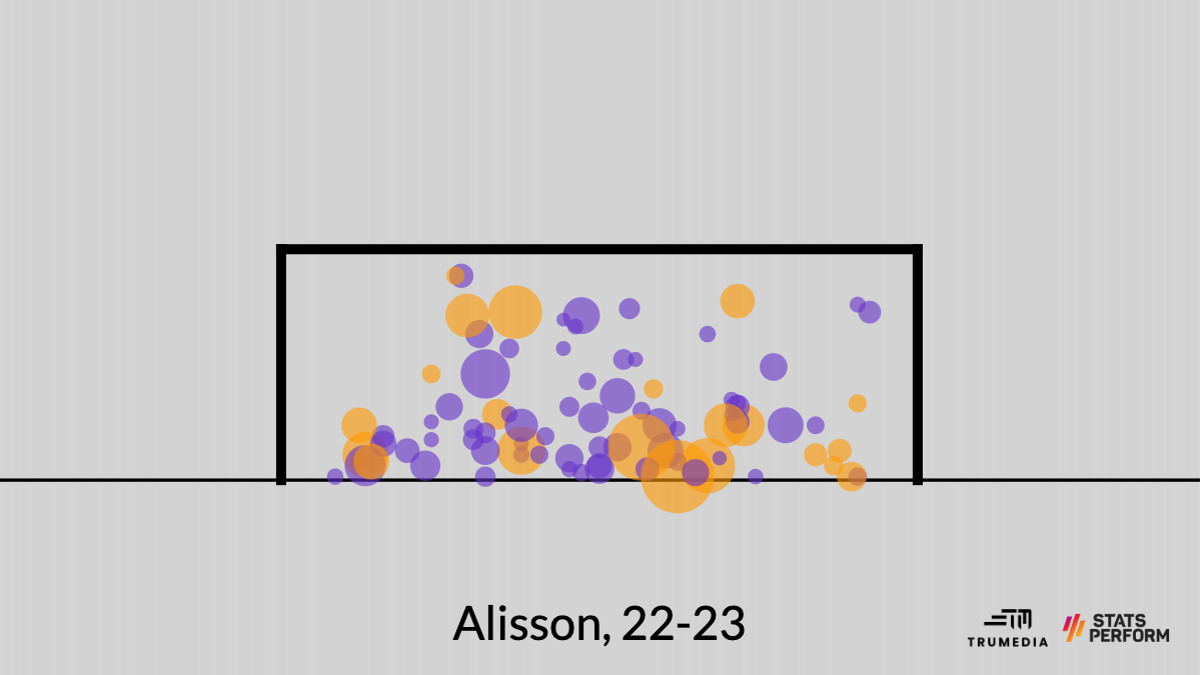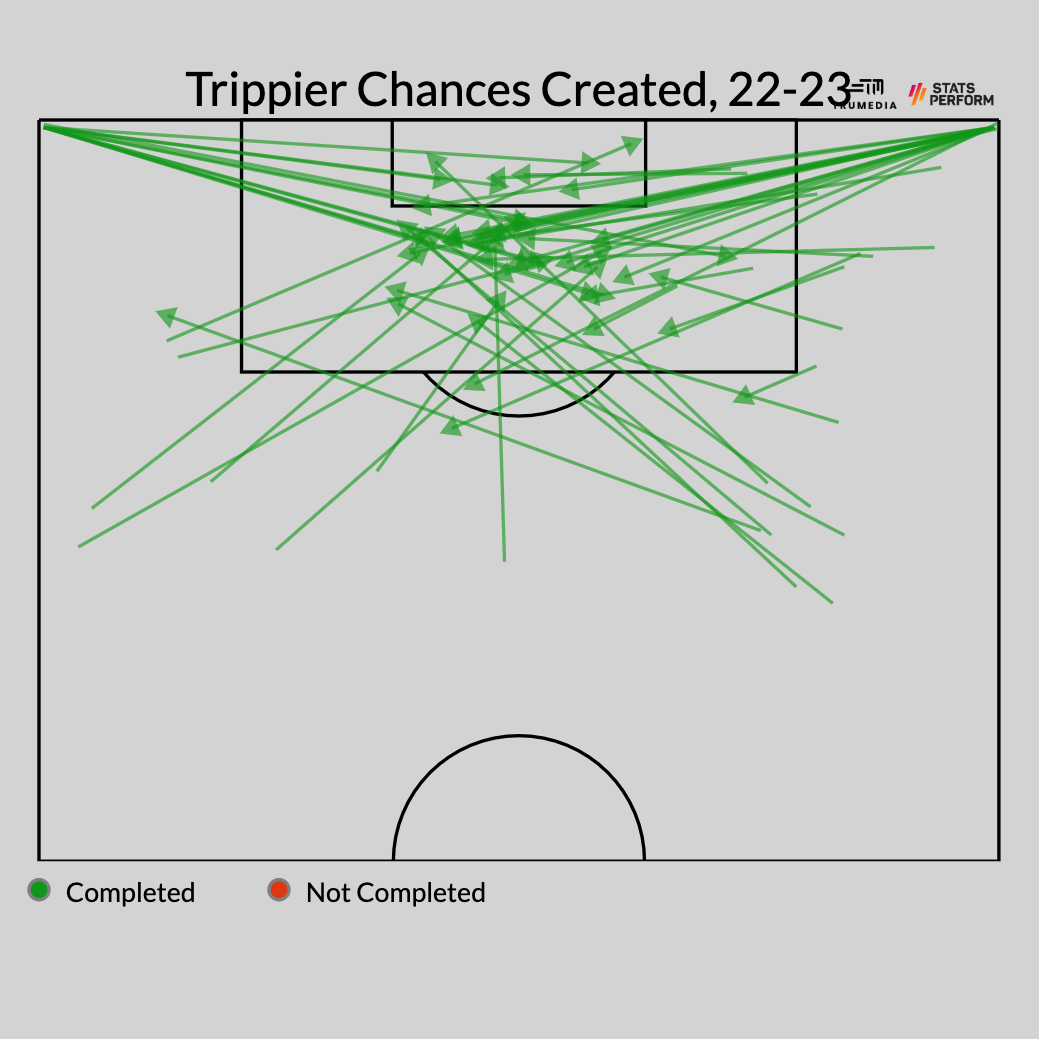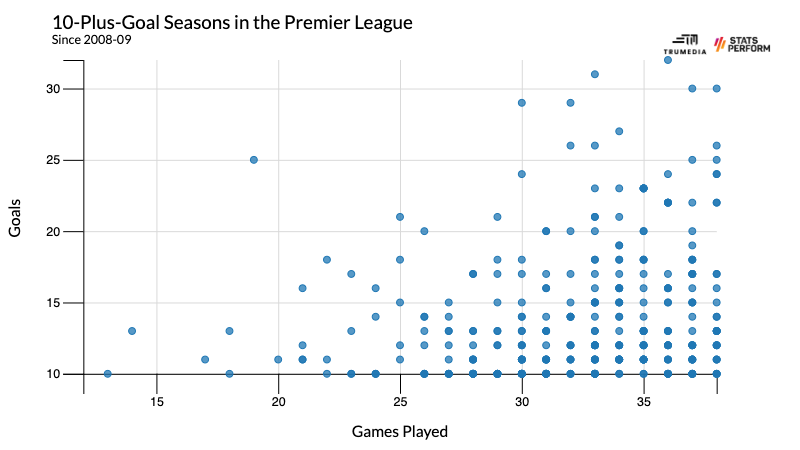Let’s just humor Todd Boehly for a second here: What if the Premier League did have an all-star game?
Back when the new Chelsea chairman proposed the idea during a leadership conference in September — has anything good ever come out of speaking at a leadership conference? — he suggested it for one simple reason: added revenue. The idea was quickly met with widespread derision. “When he finds a date for that, he can call me,” Liverpool manager Jurgen Klopp said. “He forgets that in the big sports in America, these players have four-month breaks. It is completely different in football.
“What can I say? Does he want to bring the Harlem Globetrotters as well and let them play against a football team?”
The nice thing about the midseason breaks in American sports is that they’re just that: breaks. They’re a recognition that seasons are long, it’s unrealistic to expect everyone to keep pushing on through the playoffs, we should reward the best players from the first half of the season and these multibillion-dollar enterprises are built on top of simple games that anyone can play.
The point of all-star games is not that they’re competitive; no, they’re supposed to be fun. They’re one moment when each competition takes a step back and tactically acknowledges that, you know what? Winning actually isn’t everything.
The Premier League, of course, famously hates breaks. While everyone else in Europe takes some time off for the winter holidays, the Premier League crams as many games as possible into the same period of time because of the same drive for revenue that caused Boehly to suggest the idea in the first place. Any kind of relaxing, restorative all-star game is probably a pipe dream within that context. So, as English soccer pushes ever deeper into the second half of its season without blinking, let us take a step back and acknowledge the best performers from the first half of the Premier League season.
With 11 starters and a full bench, here are your 2022-23 Premier League All-Stars.
All stats via Stats Perform unless otherwise noted.
Your starting XI
 Keeper: Alisson, Liverpool
Keeper: Alisson, Liverpool
Through 19 games, Alisson has five clean sheets — the 10th-best rate in the league. And he has saved 73.9% of the shots he has faced — the seventh-best mark in the league. The same goes for his goals-allowed rate — 1.32 per game, the seventh best in the league. So, uh, why the heck is he on this All-Star team?
Well, if you’ve watched Liverpool this season and seen firsthand their complete inability to handle any opposition possession that breaks through their press, you’d probably be surprised that 13 other teams in the league are conceding goals at a higher clip. Alisson, quite literally, is the only reason that’s true.
If you haven’t watched Liverpool this season, then here are some stats: Among all keepers in the league, Alisson is facing the toughest shots. Based on where they’re attempted from and where they end up on the goal frame, the average shot hit toward Alisson has a 34% chance of turning into a goal. For comparison, Nick Pope, who has allowed the fewest goals in the league this season, is facing shots with an average goal probability of 23%, which is the lowest in the league.
In total, Alisson has faced 88 shots on target, so you’d expect the average keeper to concede 32.1 goals. Strip out the one own goal scored against him, and he has conceded 24 goals — or 8.1 fewer than expected.

That’s by far the best margin in the Premier League, and it’s just a continuation of an already-stellar career. The Brazilian No. 1 has saved about 23 goals more than expected since his lights-out final season with Roma in 2017-18. On top of his shot-stopping, he’s one of the world’s most capable sweeper-keepers, he’s dominant against crosses and he’s currently running a four-season streak of scoring or assisting on a goal.
Alisson isn’t just the best keeper in the Premier League. He’s the best keeper in the world.
 Right back: Kieran Trippier, Newcastle
Right back: Kieran Trippier, Newcastle
Outside of center forward, this was probably the easiest choice on the list. While Trent Alexander-Arnold and Trippier have had similar attacking outputs this season, one is part of the chaotic mess that’s forced Alisson to make so many saves, and the other is part of the group that’s conceded the worst shots and fewest goals so far this season.
On the other end, the 32-year-old is Newcastle’s most important attacking player. He leads all Premier League fullbacks in shot-creating actions, which are any of the two actions that occur before a shot’s attempted. When Newcastle work a possession into an attempt, chances are Trippier played a major role. He in the 91st percentile among fullbacks for progressive passes completed, and he’s the leader in expected assists per 90 minutes with 0.32.

On top of all that, Newcastle have, quite clearly, been the third-best team in the Premier League through the first half of the season. (See: their goal differential.) Trippier has been on the field for 99% of the minutes — more than any other outfield player at the club.
 Center backs: William Saliba and Gabriel, Arsenal
Center backs: William Saliba and Gabriel, Arsenal
Is selecting a pair, rather than individuals, cheating? Can you cheat a theoretical exercise that you yourself created in your mind and therefore exists beyond the bounds of traditional bounds of morality and ethics, not to mention legality?
Anyway, there still really aren’t any great objective ways to measure center-back play. The subjective ways aren’t great, either. Someone who works with top clubs in Europe once told me that he had to cross-reference his in-person scouting with a player’s ratings in the video game FIFA because you can’t really tell how fast a center back is by just watching a match. Sure, you can tell he’s faster than the players he’s playing against or that he’s fast in the situations you see him put into, but when you’re scouting, you’re doing so because you’re planning on removing the player from that context and, you know, signing him for your team.
Plus, every team asks for something different from its center backs — the Newcastle center backs and the Leeds center backs might as well be playing different sports — so how do you rate them against one another?
Instead of attempting to answer that, we’re taking the easy — and frequently, more accurate — way out and riding with these two:
From an xG conceded perspective, Manchester City have been the best defense in the league this season, but they’ve seemingly been rotating center backs nonstop since the start of the season. Arsenal, meanwhile, are second in xG conceded, but I think both Saliba and Gabriel do more pure defending — making clearances and blocks — than we’ve come to expect from center backs on teams as good as Arsenal currently are. Four other teams control more possession than the Gunners have this season.
More simply, Arsenal have 50 points midway through the season. They’ve played 19 matches, which adds up to 1,710 minutes of regulation. Saliba and Gabriel have been out there together for all but 15 of them.
 Left back: Andy Robertson, Liverpool
Left back: Andy Robertson, Liverpool
On the one hand, Liverpool’s defense is terrible. This season has been a massive disappointment. How can you have two Liverpool players as part of your back five?
On the other hand, the Premier League’s left-back pool isn’t particularly inspiring. Oleksandr Zinchenko hasn’t even played 1,000 minutes, so we’re not counting him. Manchester City have a new left back every other game, and Joao Cancelo might not even be a starter anymore? Ben Chilwell is injured. Aaron Cresswell plays for a team (West Ham) that’s barely outside of the relegation zone.
Dan Burn is doing a nice job at Newcastle, but he’s still Dan Burn. Luke Shaw is having a solid season for Manchester United, but is he better than Robertson because Manchester United have won a bunch of one-goal games and have a better record?
Despite missing a chunk of time for injury, Robertson is still leading all Premier League left-backs in assists with five and expected assists with 3.35. On top of that, he’s the best off-ball fullback in the league, as he leads all players at his position with 5.1 progressive passes received per 90 minutes. He’s also in the 96th percentile for shot-creating actions and the 80th percentile for progressive passes completed.
Even in a somewhat down year, Robertson remains the class of the league at his position.
 Defensive midfield: Rodri, Manchester City
Defensive midfield: Rodri, Manchester City
The tricky thing about selecting Manchester City players for a team like this is that Pep Guardiola’s preferred lineup seems to change every few days. I want to reward players who are, you know, on the field and helping their team win matches. City are, in my opinion, still the best team in the Premier League, but there’s a wider collection of players who are contributing to that fact than at, say, Newcastle or Arsenal.
Halfway through the season, only one outfield player has been on the field for at least 90% of their minutes, and it’s Rodri, the guy who’s, uh, good at everything?
Need someone to break up a counterattack? Win a contested header in midfield? Pass under pressure? Drive the ball forward with a pass? Drive the ball forward with a dribble? Anchor a system that frequently throws seven or eight players ahead of the ball? He has done it all at City, and this season, he has even added a little bit to his game.
Rodri has already created 2.2 expected assists, which is more than his full-season mark in either of the previous two campaigns. And he’s averaging 3.4 shot-creating actions per 90 minutes, after never breaking 3.0 in either of his first three seasons at City. He has won possession that then led to a shot 34 times — nine more than anyone else in the league. And he has been involved in 127 open-play possessions that have ended in a shot — also more than anyone else in the league.
It’s really hard to play as holding midfielder for Pep Guardiola; your margin for error is pretty much zero in every aspect of the game, and yet Rodri is doing it just about as well as anyone conceivably could. Somehow, he didn’t even make the top 30 in Ballon d’Or voting last season.
He might be the best defensive midfielder in the world!
He’d rather swim with a hippo than a crocodile!
Let’s show the guy some respect.
 Center midfield: Bruno Guimaraes, Newcastle
Center midfield: Bruno Guimaraes, Newcastle
I still don’t really understand how everyone else let him get to Newcastle. If FBref’s wages estimations are even remotely accurate, he’s making way less than he should, and the transfer fee was a reasonable €42.1 million from Lyon, per Transfermarkt. Yes, he joined Newcastle after the Saudi takeover, but the team was still in the middle of a relegation battle when they signed him!
Bruno was one of the best midfielders in France — a league that tends to translate pretty well to the Premier League despite all the “farmer’s league” jokes — at 22 and 23 years old. The list of teams that could use a midfielder like Guimaraes is [tries to read off the list of every professional soccer club on planet earth but it takes so long because teams keep disappearing while new ones spring up that I’m eventually engulfed by the tsunami that scientists are predicting will hit the west coast of North America at some indeterminate future date].
Instead Guimaraes, along with Trippier and a bunch of marginal upgrades throughout the rest of the squad, has pushed the Newcastle project five years ahead of schedule.
Imagine if Liverpool had signed him instead of Luis Diaz? It probably doesn’t have as much of an effect as we think — and Diaz really did help drive the team’s push for four titles last season — but you’re removing Newcastle’s best player and plugging him into Liverpool’s biggest area of need. With a do-everything dynamic physical presence in the middle of the field, where are Liverpool in the table? And without him, what does that do to Newcastle? Do the two teams swap places in the table?
It’s not quite as simple as that, but Guimaraes really does seem like the kind of midfielder capable of driving teamwide performance in a significant way. He doesn’t stand out in any particular statistical category, but he’s a physical machine and above average at just about every aspect of midfield play. So, no matter what shape the game takes, what spaces are available across a given 90 minutes, he’s going to be proficient at whatever situation he gets put into.
The game looks easy for him, sure, but he makes the game easier for everyone else, too.
 Attacking midfield: Martin Odegaard, Arsenal
Attacking midfield: Martin Odegaard, Arsenal
At the beginning of the season, I ranked the top 100 players in the Premier League. Odegaard came in at No. 59, with the following analysis:
In his first season as a full-time starter in the Big Five leagues, Odegaard registered 0.36 non-penalty goals plus assists per 90 minutes as Real Sociedad finished sixth in LaLiga. In his second season as a full-time starter in the Big Five leagues, Odegaard registered 0.36 non-penalty goals plus assists per 90 minutes as Arsenal finished fifth in the Premier League. The question for Odegaard and Arsenal going forward is twofold:
1) Can he become a more impactful player (more goals, assists, progressive passes) as he ages into his prime and better players surround him?
2) Can he find other ways to contribute that don’t require him to constantly be on the ball?
Boy, do those questions look silly in hindsight! Of course he can; he did.
Despite taking fewer touches per game than he ever has in his professional career, Odegaard has already set a career high in non-penalty goals with eight. He’s attempting 2.9 shots per game after averaging about 1.6 over his first two seasons with Arsenal. And much of that comes down to his improved movement off the ball, as he’s averaging two more touches inside the penalty area than last season and he’s receiving more progressive passes than ever before.
And despite the increase in shots and the decrease in passing, his bedrock skill — the creativity — hasn’t gone anywhere. He’s averaging 0.30 expected assists per 90 minutes — more than in either of the previous two seasons — and he has increased his number of progressive passes, too.
All in all, it adds up to 0.77 non-penalty goals+assists per 90 minutes — the leading mark for the best team in the league. When you consider that he’s technically Arsenal’s fourth attacker — playing behind a striker and two wingers — those numbers are even more impressive.
Halfway through the season, he’d be my Player of the Season.
 Right Wing: Bukayo Saka, Arsenal
Right Wing: Bukayo Saka, Arsenal
While he doesn’t quite have the same technical ability yet, Saka is basically the next Riyad Mahrez. He’s constantly stressing the defense with his expansive off-ball movement and then when he gets the ball, he’s constantly forcing the opponent to react.
Part of that is just gravity; defenses know how dangerous he is, so whenever the ball gets shifted over to his side, the backline immediately tilts in his direction. That opens up all kinds of space on the back post, which creates one of the trademark passages of play we’ve seen from Arsenal this season: the ball gets shifted to the right, the defense scrambles over and then Saka clips a ball into the box, as his teammates crash into the space. Chaos, typically, ensues. See: the first goal against Nottingham Forest.
The other part is how direct he is with the ball. Saka leads the league in chance-creating carries: when a player carries the ball at least five meters and it leads to a shot for himself or for a teammate. He has scored seven goals and added seven assists, and that’s despite him mainly being left to fend for himself on the right side.
Arsenal’s right-back, Ben White, just doesn’t get forward much, so the typical space awarded to an inverted winger doesn’t exist for Saka. His ability to generate goal-scoring opportunities without that kind of help has played a large role in Arsenal’s defensive improvement, too, as they’re not at risk of being exposed from White being pushed up too high.
Saka is fantastic — and he’s only 21.
 Left Wing: Marcus Rashford, Manchester United
Left Wing: Marcus Rashford, Manchester United
Back in December, Erik ten Hag made what seemed like a completely ridiculous statement: only Kylian Mbappe was better than Marcus Rashford. Of course, the quote was taken out of context — as these things are, especially in the age of one-liners being turned into provocative “art” for Instagram — but Ten Hag was actually just comparing the two in one specific sense.
“From the first moment, I recognised huge potential,” he said. “And now to get out the potential, I believe when Marcus’ positioning is on the back of the defending line, there is almost no better player in the world. There is Mbappe in this moment, a type like him, but when he [Rashford] is getting in that position, he’s great and you see he’s really improved also out of possession.”
Rashford hasn’t really done all that much this season outside of scoring goals, but, well, that’s the whole point, isn’t it? Among Premier League wingers and attacking midfielders, Rashford takes fewer touches than 87% of the other players at those positions. Despite that, he has been involved in open-play possessions that have resulted in shots worth 13.5 xG — more than any other winger in the league. So even when he’s not touching the ball, he’s affecting the game, because if you do let him touch the ball, something bad is probably going to happen to you.
Without a legitimate center forward option on the roster and close to a zero from both Jadon Sancho and Antony on the other wing, Rashford has carried United’s attack up into the top four.
 Center Forward: Erling Haaland, Manchester City
Center Forward: Erling Haaland, Manchester City
These are all the 10-or-more-goal seasons in the Premier League since 2008-09, plotted against the games each player played. See if you can spot Haaland.

He’s pretty good, you guys.
The substitutes
I split this up into seven positions: one keeper, one center-back, one fullback, two midfielders and two forwards/wingers.
In goal, it’s Fulham‘s Bernd Leno, who has been the best full-time shot-stopper in the league after Alisson. He’s the biggest reason Fulham are currently in seventh place.
At center back, our backup is Newcastle’s Fabian Schar. He has played almost every minute for the team that has conceded only 11 goals through 20 games, and he has done a little bit of everything. For a team that shows the value of marginal gains throughout the roster, he’s the poster boy. Then, at fullback, we’re going with Arsenal’s Ben White. Playing one more conservative fullback who helps pull the strings from deep is a growing trend across the sport, so it feels right to have one of these guys in the team.
In the midfield, we’re going to have a bunch of “snubs,” but first we’ll go with West Ham’s Declan Rice. Yes, they’re technically in a relegation fight, but West Ham’s xG differential is top-half-of-the-table quality. Plus, as a midfielder, Rice has almost no effect on whether the chances his team creates or concedes get converted. He’s the next Nemanja Matic: huge, rangy and still able to drive play forward with the ball at his feet.
The other midfielder: Manchester City’s Kevin De Bruyne. It seems like he’s having a down year, and he’s leading the Premier League in assists (both real and expected).
Lastly, the first of the two attackers is Tottenham’s Harry Kane. With this team I tried to reward players for their production, more so than what their underlying performance says their performance should be. We’re rewarding guys for what they did, not what they will do. That said, you can’t really control whether a player converts the pass you play to him; looking at assists perhaps favors players with teammates who are better finishers.
For our purposes here, we could, say, combine non-penalty goals scored with expected assists to get a truer sense of who should be on the team. Here are all the guys to hit at least 10 non-penalty goals+expected assists so far this season:
- 1) Erling Haaland: 23.35
- 2) Harry Kane: 15.83
- 3) Kevin De Bruyne: 12.81
- 4) Martin Odegaard: 12.27
- 5) Gabriel Martinelli: 11.21
- T-6) Miguel Almiron: 10.93
- T-6) Marcus Rashford: 10.93
- 8) Ivan Toney: 10.42
- 9) Mohamed Salah: 10.07
The only reason Kane isn’t in the starting lineup is that Haaland exists and they play the same position. Plus, I wanted the lineup to represent the kind of lineup the best teams in the league play: three complimentary midfielders, fullbacks on their actual sides, two wingers on their actual sides.
So, the other attacker will be … Brentford‘s Ivan Toney. Martinelli and Almiron both could easily be on the team; hell, Martinelli has a case as a starter. But we’re giving the edge to Toney because those goals and assists make up a much bigger chunk of the team’s overall totals. Plus, Brentford are currently in eighth, in their second-ever season in the Premier League. They deserve at least one All-Star.
Credit: Source link